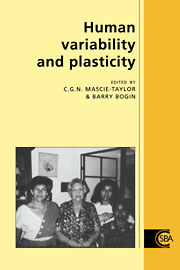Book contents
- Frontmatter
- Contents
- List of contributors
- Foreword
- 1 The pervasiveness of plasticity
- 2 Plasticity in early development
- 3 Plasticity in the growth of Mayan refugee children living in the United States
- 4 The place of plasticity in the study of the secular trend for male stature: an analysis of Danish biological population history
- 5 Plasticity, growth and energy balance
- 6 The study of migrants as a strategy for understanding human biological plasticity
- 7 Human migration: effects on people, effects on populations
- 8 The use of surnames in the study of human variation and plasticity
- 9 A biological anthropological approach to measuring societal stress of parasitic disease: a case study of schistosomiasis
- 10 Biological adaptability, plasticity and disease: patterns in modernizing societies
- 11 Human biological adaptability with special emphasis on plasticity: history, development and problems for future research
- Index
10 - Biological adaptability, plasticity and disease: patterns in modernizing societies
Published online by Cambridge University Press: 28 October 2009
- Frontmatter
- Contents
- List of contributors
- Foreword
- 1 The pervasiveness of plasticity
- 2 Plasticity in early development
- 3 Plasticity in the growth of Mayan refugee children living in the United States
- 4 The place of plasticity in the study of the secular trend for male stature: an analysis of Danish biological population history
- 5 Plasticity, growth and energy balance
- 6 The study of migrants as a strategy for understanding human biological plasticity
- 7 Human migration: effects on people, effects on populations
- 8 The use of surnames in the study of human variation and plasticity
- 9 A biological anthropological approach to measuring societal stress of parasitic disease: a case study of schistosomiasis
- 10 Biological adaptability, plasticity and disease: patterns in modernizing societies
- 11 Human biological adaptability with special emphasis on plasticity: history, development and problems for future research
- Index
Summary
Summary
Human population biology is one of the few remaining integrative multidisciplinary sciences in today's reductionist scientific world. The reductionist approach is perhaps nowhere better exemplified than in the biomedical sciences where both long-term research and the ability to integrate and synthesize large bodies of data toward a solution of a broadly defined problem are now all but non-existent. In contrast, the concepts of human adaptability and plasticity and their development within an ecological framework emerged from the so-called ‘golden age’ of human biology in the 1960s and continue to thrive despite the changes that have taken place over the past three decades. This theme focuses on issues of human–environment interactions and resultant biological and behavioral outcomes in populations worldwide. The golden age of human biology flourished at a time when research dollars were plentiful, theoretical conceptualizations and constructs broad-based, multidisciplinary approaches emphasized and when many isolated human groups were beginning to emerge into the modern world. The historical and theoretical aspects regarding biological adaptability studies are appropriately addressed by L. Schell (this volume) and will not be reiterated here.
Among the contributors and supporters to an understanding of human biological adaptability was Professor Gabriel Lasker, whose 1969 article (Science 166, 1480–6) helped focus this issue by presenting a three-part construct of human biological adaptation that was defined as ‘… a modification in structure or function that enables an organism to survive and reproduce’ (Lasker, 1969). It was represented by a temporal sequence that included the concepts of genetic adaptation, developmental adaptation or plasticity (lifelong) and acclimatization (short-term).
- Type
- Chapter
- Information
- Human Variability and Plasticity , pp. 190 - 212Publisher: Cambridge University PressPrint publication year: 1995
- 1
- Cited by



